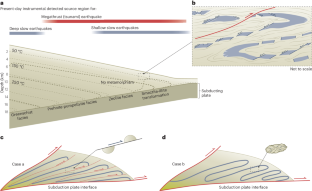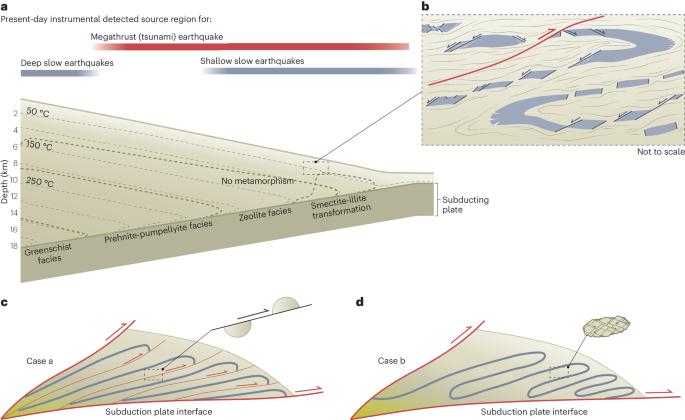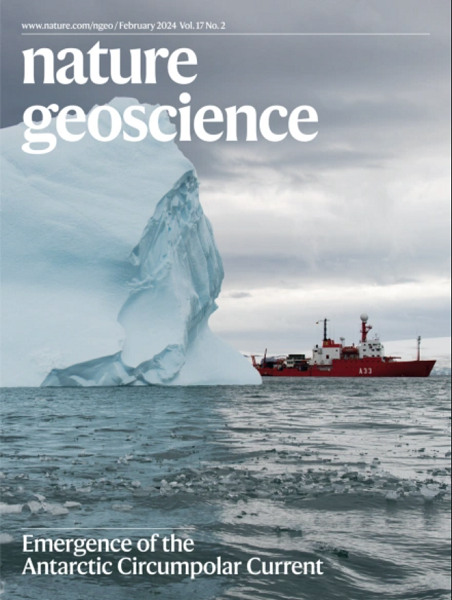褶皱相关变形在浅层增生棱岩地震中的作用
IF 15.7
1区 地球科学
Q1 GEOSCIENCES, MULTIDISCIPLINARY
引用次数: 0
摘要
俯冲带前沿浅层慢速地震的来源仍不清楚,但通常归因于断层和剪切带。对现代和古代浅层增生棱柱体--从俯冲板块上刮下并在板块交汇处增生到凌动板块上的沉积物和火山沉积物的楔形堆积体--的结构研究记录了大量与数米至数百公里尺度的翻转褶皱和后退褶皱有关的脆性结构。这些褶皱是俯冲带前端岩石屈曲和剪切的产物。目前,在地震周期时间尺度上的增生楔动力学模型中,通常不考虑这类结构,而是将重点放在主要断层的滑动作用上。在此,我们认为与褶皱相关的脆性结构也可能与应变率升高和存在高流体压力时的瞬态变形事件有关。它们有可能在增生棱柱体的低有效法向应力下引起分布式微地震群,并影响地表位移的分布。本文章由计算机程序翻译,如有差异,请以英文原文为准。


Role of folding-related deformation in the seismicity of shallow accretionary prisms
The sources of shallow slow earthquakes at subduction zone fronts remain unclear, but are commonly attributed to faults and shear zones. Structural studies of modern and ancient shallow accretionary prisms — wedge-shaped stacks of sediments and volcanic deposits scraped from subducting slabs and accreted onto the overriding plates at convergent plate boundaries — document a plethora of brittle structures associated with metres to plurikilometre-scale overturned and recumbent folds. These folds are the product of rock buckling and shearing at the front of subduction zones. At present, such structures are not commonly considered in models of the dynamics of accretionary wedges at the timescale of the seismic cycle, instead focusing on the role played by slip on major faults. Here we argue that fold-related brittle structures might also be associated with transient deformation events at elevated strain rates and in the presence of high fluid pressure. They have the potential to cause distributed microearthquake swarms occurring under low effective normal stress in accretionary prisms, and to affect the distribution of surficial displacement. Folding-related brittle deformation structures in accretionary wedges may contribute to shallow seismicity in subduction zones, according to a compilation of structural evidence.
求助全文
通过发布文献求助,成功后即可免费获取论文全文。
去求助
来源期刊

Nature Geoscience
地学-地球科学综合
CiteScore
26.70
自引率
1.60%
发文量
187
审稿时长
3.3 months
期刊介绍:
Nature Geoscience is a monthly interdisciplinary journal that gathers top-tier research spanning Earth Sciences and related fields.
The journal covers all geoscience disciplines, including fieldwork, modeling, and theoretical studies.
Topics include atmospheric science, biogeochemistry, climate science, geobiology, geochemistry, geoinformatics, remote sensing, geology, geomagnetism, paleomagnetism, geomorphology, geophysics, glaciology, hydrology, limnology, mineralogy, oceanography, paleontology, paleoclimatology, paleoceanography, petrology, planetary science, seismology, space physics, tectonics, and volcanology.
Nature Geoscience upholds its commitment to publishing significant, high-quality Earth Sciences research through fair, rapid, and rigorous peer review, overseen by a team of full-time professional editors.
 求助内容:
求助内容: 应助结果提醒方式:
应助结果提醒方式:


